Starter Replacement PG260
Removal Procedure
Caution: Unless directed otherwise, the ignition and start switch must be in the OFF or LOCK position, and all electrical loads must be OFF before servicing
any electrical component. Disconnect the negative battery cable to prevent an electrical spark should a tool or equipment come in contact with an exposed electrical terminal. Failure to follow these precautions may result in personal injury and/or damage to
the vehicle or its components.
- Disconnect
the negative battery cable. Refer to Negative Battery Cable in
Battery Cable Replacement
.
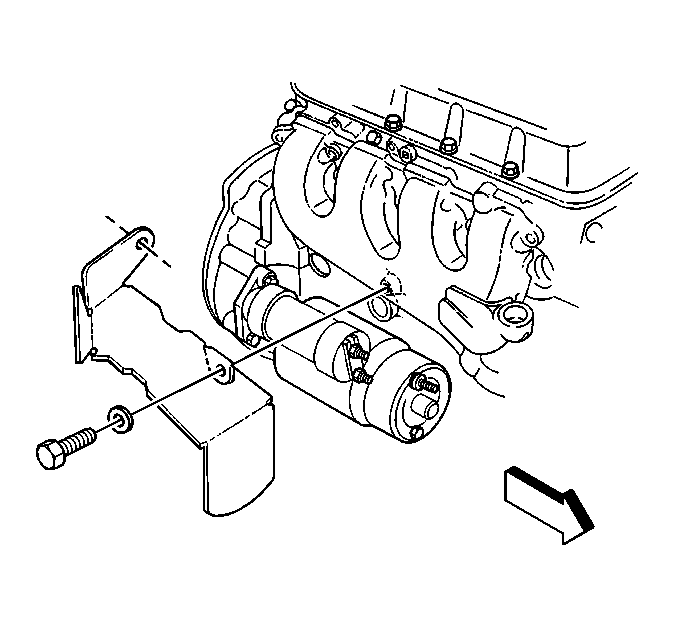
- Remove the heat shield if the vehicle is equipped with a heat shield.
- Remove the starter ground cables from the starter if the starter
is equipped with starter ground cables.
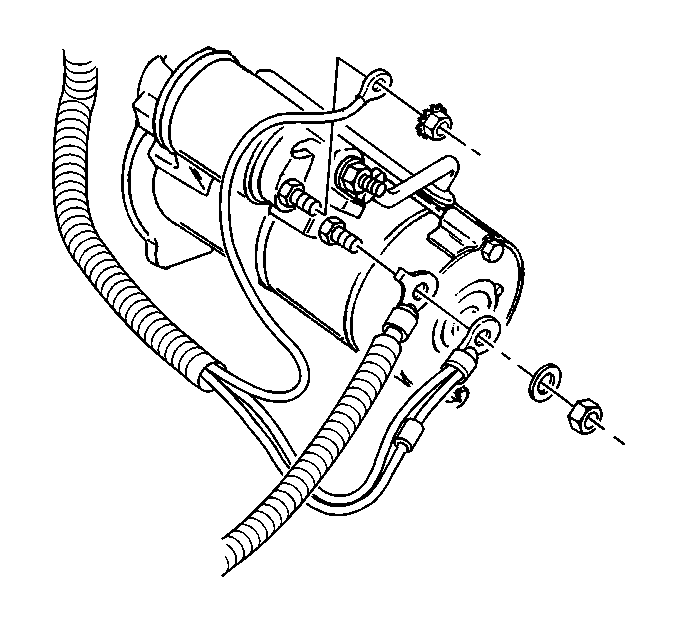
- Remove the electrical
connectors from the starter motor.

- Remove the starter motor
bolts.
- Remove the starter motor from the engine.
- Clean the following components:
| • | The starter motor solenoid terminals |
| • | The electrical connector terminals |
- Inspect the starter ring gear teeth for wear and damage.
Replace any worn parts.
Installation Procedure

- Install the starter motor
to the engine.
Notice: Use the correct fastener in the correct location. Replacement fasteners
must be the correct part number for that application. Fasteners requiring
replacement or fasteners requiring the use of thread locking compound or sealant
are identified in the service procedure. Do not use paints, lubricants, or
corrosion inhibitors on fasteners or fastener joint surfaces unless specified.
These coatings affect fastener torque and joint clamping force and may damage
the fastener. Use the correct tightening sequence and specifications when
installing fasteners in order to avoid damage to parts and systems.
- Install the starter
motor bolts.
Tighten
Tighten the starter motor bolt to 40 N·m (30 lb ft).

- Install the electrical
connectors to the starter motor.
Tighten
Tighten the battery positive cable nut to 10 N·m (89 lb in).
- Use the following procedure in order to install the starter ground
cables to the starter if the starter is equipped with starter ground cables:
| 4.1. | Clean the starter grounding area. |
| 4.2. | Coat the starter grounding area with a copper-impregnated ground
sealer. |
| 4.3. | Install the following components to the ground stud on the starter
motor end frame: |
| • | The starter motor ground cable |
| • | The engine harness ground wire |
| 4.4. | Install the starter ground cable to the stud on the field frame. |
Hold the hex-shaped base of the ground stud while tightening the nut.
| 4.5. | Install the overcrank protection wire harness. |

- Install the heat shield if the vehicle is equipped with a heat shield.
Use the heat shield bolt in order to secure the heat shield.
Tighten
Tighten the heat shield bolt to 12 N·m (106 lb in).
- Connect the negative battery cable.Refer to
Battery Cable Replacement
.
Starter Replacement 28MT
Removal Procedure
Caution: Unless directed otherwise, the ignition and start switch must be in the OFF or LOCK position, and all electrical loads must be OFF before servicing
any electrical component. Disconnect the negative battery cable to prevent an electrical spark should a tool or equipment come in contact with an exposed electrical terminal. Failure to follow these precautions may result in personal injury and/or damage to
the vehicle or its components.
- Disconnect
the negative battery cable. Refer to Negative Battery Cable in
Battery Cable Replacement
.
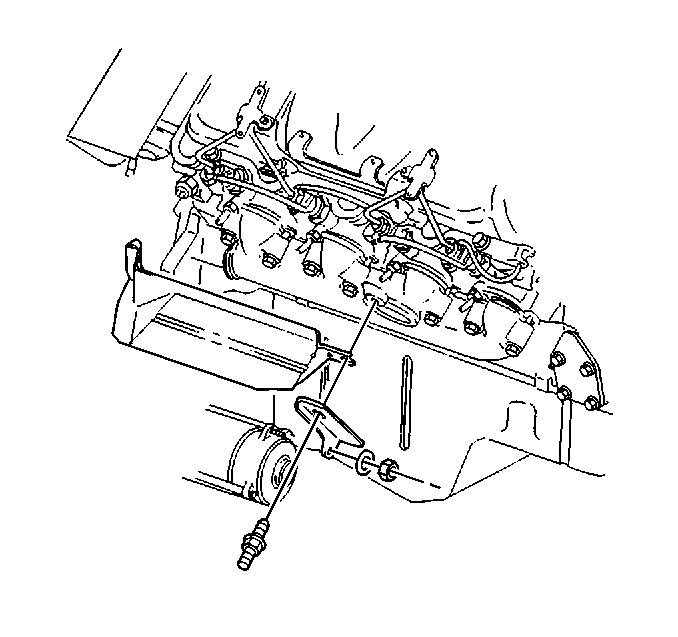
- Remove the heat shield if the vehicle is equipped with a heat shield.
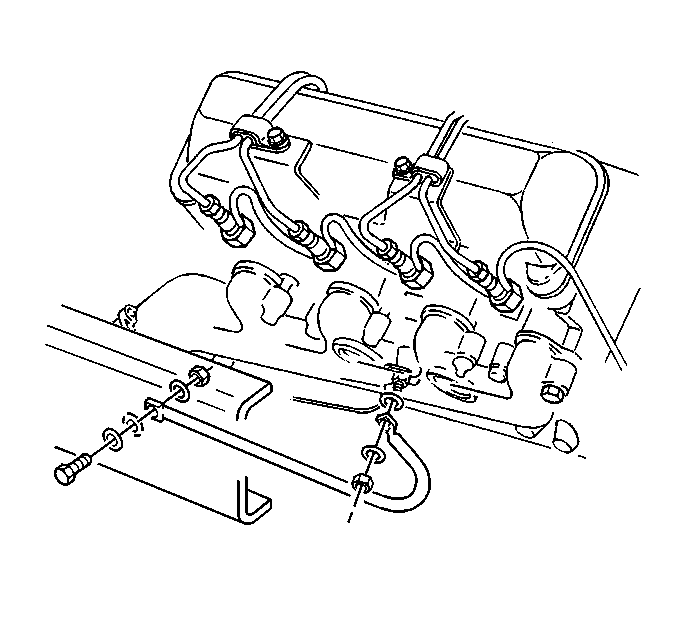
- Remove the starter ground
cables from the starter if the starter is equipped with starter ground cables.

- Remove the electrical
connectors from the starter motor.
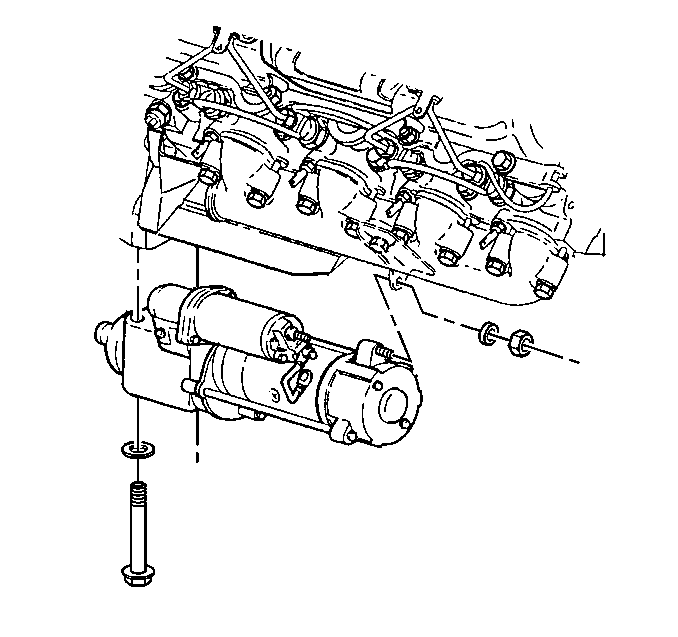
- Remove the starter motor
bolts.
- Remove the starter motor from the engine.
- Clean the following components:
| • | The starter motor solenoid terminals |
| • | The electrical connector terminals |
- Inspect the starter ring gear teeth for wear and damage.
Installation Procedure

- Install the starter motor
to the engine.
Notice: Use the correct fastener in the correct location. Replacement fasteners
must be the correct part number for that application. Fasteners requiring
replacement or fasteners requiring the use of thread locking compound or sealant
are identified in the service procedure. Do not use paints, lubricants, or
corrosion inhibitors on fasteners or fastener joint surfaces unless specified.
These coatings affect fastener torque and joint clamping force and may damage
the fastener. Use the correct tightening sequence and specifications when
installing fasteners in order to avoid damage to parts and systems.
- Install the starter
motor bolts.
Tighten
Tighten the starter motor bolt to 44 N·m (33 lb ft).

- Install the electrical
connectors to the starter motor.
Tighten
| • | Tighten the battery positive cable nut to 16 N·m
(12 lb ft). |
| • | Tighten the starter solenoid nut to 2 N·m (18 lb in). |
- Use the following procedure in order to install the starter ground
cables to the starter if the starter is equipped with starter ground cables:
| 4.1. | Clean the starter grounding area. |
| 4.2. | Coat the starter grounding area with a copper-impregnated ground
sealer. |
| 4.3. | Install the following components to the ground stud on the starter
motor end frame: |
| • | The starter motor ground cable |
| • | The engine harness ground wire |
| 4.4. | Install the starter ground cable to the stud on the field frame. |
Hold the hex-shaped base of the ground stud while tightening the nut.
| 4.5. | Install the overcrank protection wire harness. |

- Install the heat shield
if the vehicle is equipped with a heat shield.
Use the heat shield bolt in order to secure the heat shield.
Tighten
Tighten the heat shield bolt to 12 N·m (106 lb in).
- Connect the negative battery cable.
Starter Replacement 37MT/300
Removal Procedure
Caution: Unless directed otherwise, the ignition and start switch must be in the OFF or LOCK position, and all electrical loads must be OFF before servicing
any electrical component. Disconnect the negative battery cable to prevent an electrical spark should a tool or equipment come in contact with an exposed electrical terminal. Failure to follow these precautions may result in personal injury and/or damage to
the vehicle or its components.
- Disconnect
the negative battery cable. Refer to Negative Battery Cable in
Battery Cable Replacement
- Remove the starter ground cables from the starter if the starter
is equipped with starter ground cables.
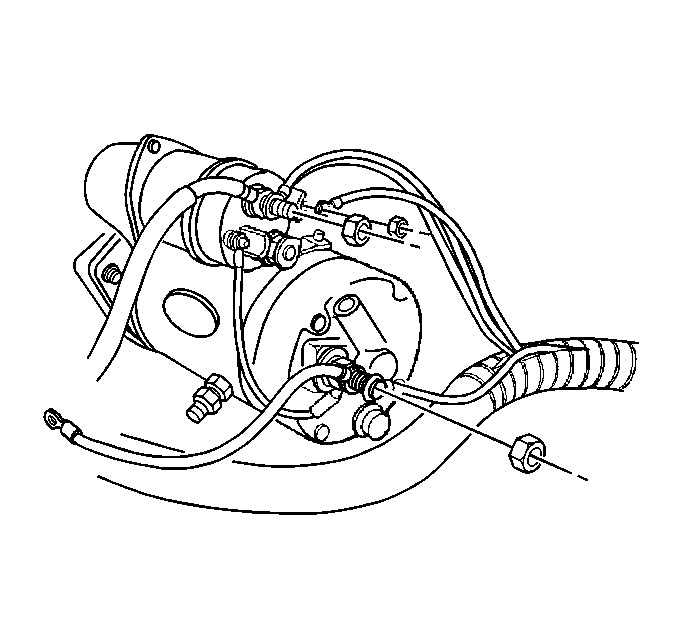
- Remove the electrical
connectors from the starter motor.
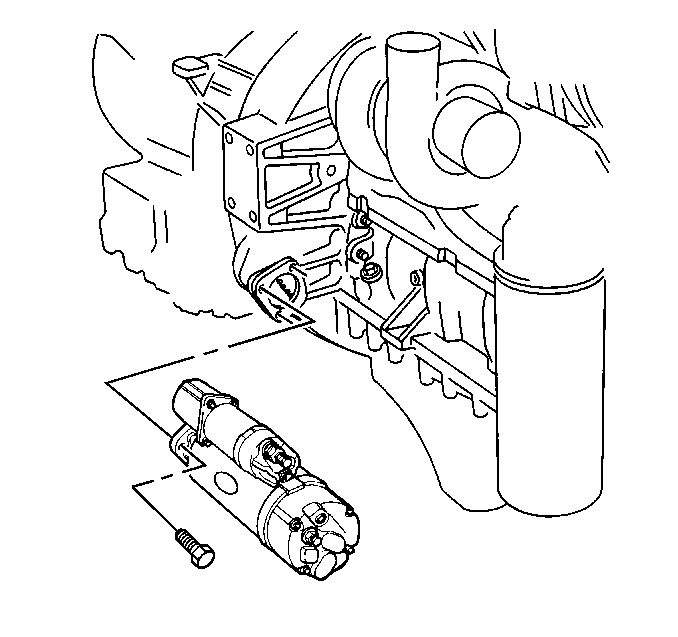
- Remove the starter motor
bolts.
- Remove the starter motor from the engine.
- Clean the following components:
| • | The starter motor solenoid terminals |
| • | The electrical connector terminals |
- Inspect the starter ring gear teeth for wear and damage.
Replace any worn parts.
Installation Procedure

- Install the starter motor
to the engine.
Notice: Use the correct fastener in the correct location. Replacement fasteners
must be the correct part number for that application. Fasteners requiring
replacement or fasteners requiring the use of thread locking compound or sealant
are identified in the service procedure. Do not use paints, lubricants, or
corrosion inhibitors on fasteners or fastener joint surfaces unless specified.
These coatings affect fastener torque and joint clamping force and may damage
the fastener. Use the correct tightening sequence and specifications when
installing fasteners in order to avoid damage to parts and systems.
- Install the starter
motor bolts.
Tighten
Tighten the starter motor bolt to 70 N·m (52 lb ft).

- Install the electrical
connectors to the starter motor.
Tighten
| • | Tighten the battery positive cable nut to 30 N·m
(22 lb ft). |
| • | Tighten the starter solenoid nut to 3 N·m (27 lb in). |
- Use the following procedure in order to install the starter ground
cables to the starter if the starter is equipped with starter ground cables:
| 4.1. | Clean the starter grounding area. |
| 4.2. | Coat the starter grounding area with a copper-impregnated ground
sealer. |
| 4.3. | Install the following components to the ground stud on the starter
motor end frame: |
| • | The starter motor ground cable |
| • | The engine harness ground wire |
| 4.4. | Install the starter ground cable to the stud on the field frame. |
Hold the hex-shaped base of the ground stud while tightening the nut.
| 4.5. | Install the overcrank protection wire harness. |
- Connect the negative battery cable.
Starter Replacement LG5
Removal Procedure
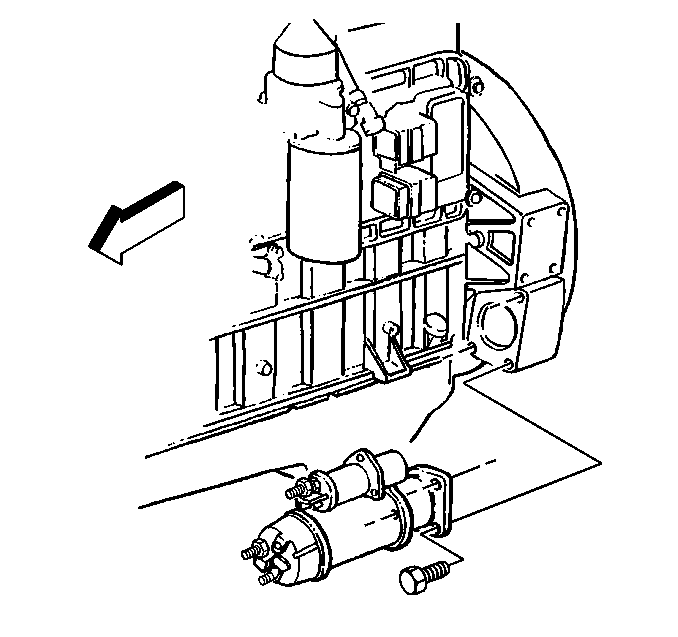
Caution: Unless directed otherwise, the ignition and start switch must be in the OFF or LOCK position, and all electrical loads must be OFF before servicing
any electrical component. Disconnect the negative battery cable to prevent an electrical spark should a tool or equipment come in contact with an exposed electrical terminal. Failure to follow these precautions may result in personal injury and/or damage to
the vehicle or its components.
- Disconnect
the negative battery cable. Refer to Negative Battery Cable
Battery Cable Replacement
.
- Remove the starter ground cable from the starter.
- Remove the electrical connectors from the starter motor.
- Remove the starter motor bolts.
- Remove the starter motor from the engine.
- Clean the following components:
| • | The starter motor solenoid terminals |
| • | The electrical connector terminals |
- Inspect the starter ring gear teeth for wear and damage.
Installation Procedure

- Install the starter motor to the engine.
Notice: Use the correct fastener in the correct location. Replacement fasteners
must be the correct part number for that application. Fasteners requiring
replacement or fasteners requiring the use of thread locking compound or sealant
are identified in the service procedure. Do not use paints, lubricants, or
corrosion inhibitors on fasteners or fastener joint surfaces unless specified.
These coatings affect fastener torque and joint clamping force and may damage
the fastener. Use the correct tightening sequence and specifications when
installing fasteners in order to avoid damage to parts and systems.
- Install the starter
motor bolts.
Tighten
Tighten the starter motor bolts to 70 N·m (52 lb ft).
- Install the electrical connectors to the starter motor.
Tighten
| • | Tighten the battery positive cable nut to 30 N·m
(22 lb ft). |
| • | Tighten the starter solenoid nut to 3 N·m (27 lb in). |
- Use the following procedure in order to install the starter ground
cable
| 4.1. | Clean the starter grounding area. |
| 4.2. | Coat the starter grounding area with a copper-impregnated ground
sealer. |
| 4.3. | Install the starter ground cable and nut to the stud on the field
frame. |
- Tighten the ground cable nut to 30 N·m (22 lb ft).
- Connect the negative battery cable.



















